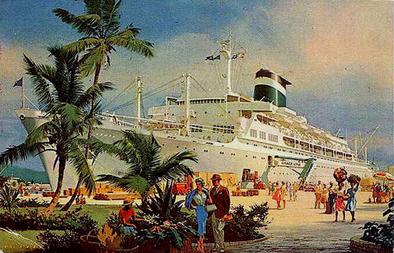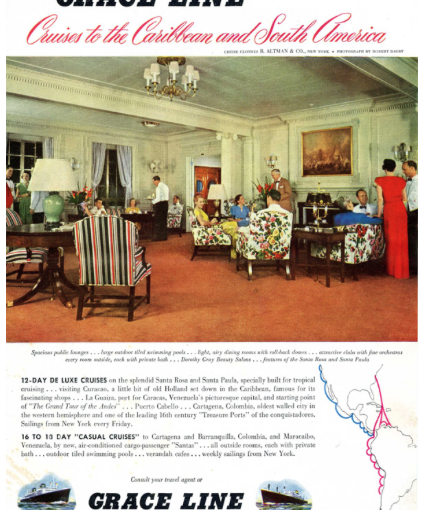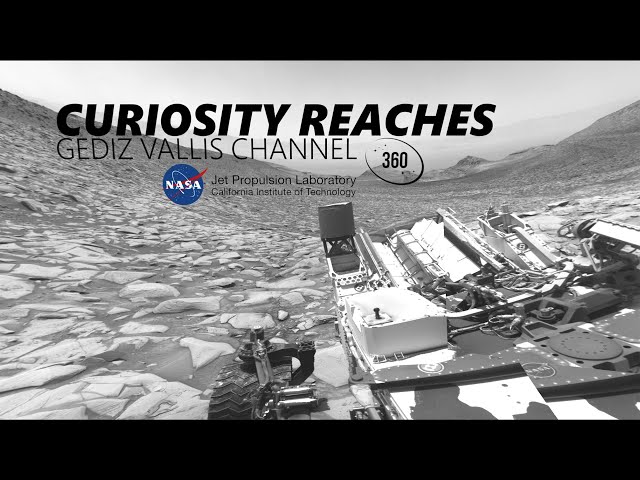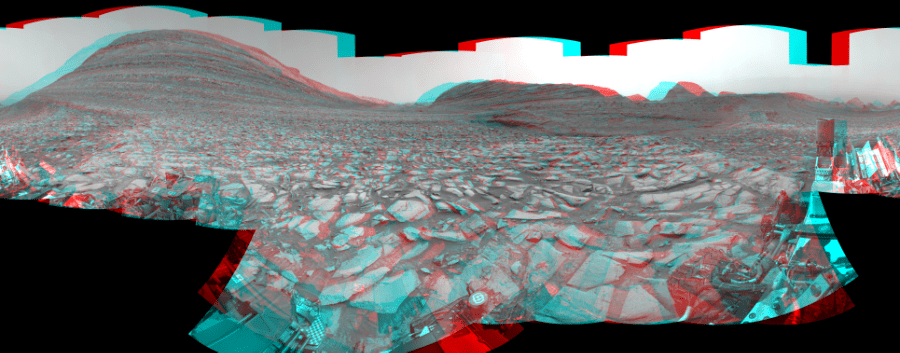Cruising The Past Cruise News
Coulter’s steamlined modern department store miracle mile los angeles, the grace line history.
Posted by: Michael Grace December 1, 2009
Cruise History – THE GRACE LINE – In the mid 1800s, the Irish-born Grace brothers, William Russell and Michael, established a commercial and shipping business in Callao, the port of Lima, Peru. They prospered, especially in the exporting of guano from the Chincha Islands to the United States, where this fertilizer was in considerable demand.
In 1865, leaving Michael in charge of their interests in Callao, William established the firm of W.R. Grace & Co., in New York. By 1880 he had become a leading citizen and was twice elected Mayor of New York, despite opposition from Tammany. In the 1890’s the company entered the steamship business with a line of freighters running from New York to the South American west coast via the Strait of Magellan flying the British flag.
Grace’s original British-flag ships had black hulls, white painted masts and booms, and a green stack with a black top. After the First World War successors were painted grey, with masts and booms of the usual mast color. Hulls became black again in 1928 and masts and booms reverted to white in 1932. (about 1959-60 Grace passenger ships again turned to grey hulls).
The early British-flag freighters all had names beginning with C, such as CACIQUE, CAPAC, CHINCHA; Names which were later repeated in ships under the American flag.
Later Grace started a service from the Pacific coast of the United States to the west coast of South America, and in 1913 took delivery of the 4,826 gross ton, 400-foot Santa Cruz from William Cramp & Sons of Philadelphia for this run. She was their first American flag ship and was especially designed to carry a large deck-load of lumber, as well as 48 passengers. three boilers provided steam for a 2400 horsepower triple expansion engine, which gave her a speed of 11-12 knots. She introduced the green funnel with white band and black top which continued to be the Grace stack colors.
Grace established regular steamship service in 1893 with a subsidiary called the New York & Pacific Steamship Co., operating under the British flag because ships built outside the United States were banned from US registry until 1905. US-flag service began in 1912 with the Atlantic and Pacific Steamship Company. The activities of both companies and the parent firm were consolidated into the Grace Steamship Company beginning in 1916. The firm originally specialized in traffic to the west coast of South America; then expanded into the Caribbean.
COLUSA, of 5873 gross tons and 424 feet, was also built in 1913, by Hamilton of Port Glasgow, Scotland, for the same service as the SANTA CRUZ. She was Grace’s last ship for British-flag operations. Three boilers and a quadruple expansion engine of 3500 horsepower gave her a service speed of 12 knots. She too, was built to carry large loads of lumber on deck. She had four masts at first, but was later given a fifth with a 100 ton boom, and handled fully assembled steam locomotives for the South American ports. Her 36 passenger capacity was later increased to 50.
In 1914 COLUSA was transferred to the U.S. flag and was renamed Santa Cecelia (a misspelling of CECILIA). Some of the British-flag ships were lost by enemy action, and only two were left at the end of the first world war. Grace also operated a cargo service from Seattle to Chile with way calls along the coast.
To restore Transpacific service, Grace bought in 1915 three ships under construction in Holland; Colombia, Ecuador and Venezuela, laid down for the Royal Netherlands West India Mail, these had been intended to run down to the west coast of South America via the Panama Canal, but had been sold on the stocks to the Norwegian owner Chr. Hannevig, who proposed to use them between New York and the South American east coast, a run discontinued by Lamport and Holt and Booth Line because of the war. Hannevig, however accepted Grace’s offer to buy the ships before they were completed. Colombia kept her name until she was lost. This unlucky ship first ran aground on Cano Island off Costa Rica in 1923, remaining there two months. Practically her whole bottom had to be removed in drydock at Balboa. In the fall of 1931 she went to her grave on the south end of Margarita Island off lower California. Venezuela struck a mine on the way out from Holland and was repaired in England.
In 1916 Grace decided to institute a passenger service from New York to ports on the west coast of South America as far as Valparaiso, Chile, and contracted for five ships; SANTA ANA, SANTA LUISA, SANTA TERESA (By Cramp) and SANTA ELISA and SANTA LEONORA (by New York Shipbuilding). These 110 passenger ships were 376 feet long with a gross tonnage of 5800. They had four boilers each and quadruple expansion engine of 3300 hp. in the Cramp ships and 3400 in the others. Their service speed of 13 knots could be exceeded by a knot.
The United States Shipping Board took these five ships over for transport duty. By the time the troops had been carried back from France, Grace had decided that four would be sufficient for the intended service, and declined return of the SANTA LEONORA, which went to the Navy and became the submarine tender CANOPUS, ultimately lost in the Philipines early in 1942. In 1926 the secondary service from New York as far as Antofagasta, Chile was begun with the SANTA CRUZ, which was joined in the following year by SANTA CECI(E)?LIA ( ex COLUSA)
Also in 1916, the company acquired a controlling interest in the venerable Pacific Mail Steamship Company, premier west coast and transpacific operator, which had already sold its big ships and retained only the lesser vessels of the Central American service.
In 1921 the Shipping Board allocated five 535 ft. President class ships for Transpacific operation by Pacific Mail Line. these were PRESIDENT CLEVELAND, (ex GOLDEN STATE), PRESIDENT LINCOLN (ex HOOSIER STATE), PRESIDENT PIERCE (ex HAWKEYE STATE), PRESIDENT TAFT (ex BUCKEYE STATE) and PRESIDENT WILSON (ex EMPIRE STATE).
COLOMBIA, ECUADOR and VENEZUELA were thus displaced and in the following year were transferred from the far east run to the intercostal run. At the same time Grace placed on the same run the freighters SANTA BARBARA, SANTA CLARA, SANTA MALTA, SANTA OLIVIA, SANTA PAULA and SANTA ROSA. These six , making connection with the President ships at San Francisco, provided fast freight service from Atlantic ports to the far east.
In 1923 the Shipping Board invited bids for the sale of the President ships operated by Pacific Mail. The Dollar Line outbid Grace and was awarded the vessels. Finding itself without ships suitable for the transpacific trade, Pacific Mail sold its registered name and goodwill to Dollar. Grace now without a transpacific connecting service, had no further use for the six intercostal freighters and sold them off to the American Hawaiian Line.
At this time Grace formed a new entity, the Panama Mail Company, to operate the small ships formerly owned and used by the Pacific Mail in the Central American trade, these ships not having been involved in the sale to Dollar. COLOMBIA, ECUADOR and VENEZUELA also remained under Grace Ownership.
In 1928 to meet competition from the Pacific Steam Navigation Company and the Chilean Line, Grace took delivery of SANTA BARBARA and SANTA MARIA, which were a great improvement over previous ships. As it was then permissible to build ships in foreign countries for U.S. flag operation and retain eligibility for mail contracts, these sisters were constructed by the Furness Shipbuilding Company in Haverton-on-Tees, England. Each had two 8-cylinder, 2 cycle Sulzer diesel engines of 4000 hp. apiece. They were the first large motor passenger ships to sail under the U.S. flag.
The service speed of these 150 passenger vessels was 16 knots, their overall length 480 ft. and their gross tonnage 8000. In later years , after the advent of the 18 knot SANTA CLARA, a project for increasing the speed of these ships was considered. It was proposed to install a third 4000 hp. diesel engine which would transmit power to the two propeller shafts through a generator and two electric motors. In view of their somewhat old-style passenger accommodations, however, these plans did not materialize.
Since only four ships were required for the Valparaiso service, SANTA ANA and SANTA LUISA were transferred to the Panama Mail’s New York-San Francisco run and were renamed respectively GUATEMALA and EL SALVADOR.
In 1929 SANTA INEZ and SANTA RITA joined the fleet. Apart from cruiser stern, short funnel and diesel propulsion, these ships built by Burmeister & Wain of Copenhagen, were much like the SANTA ANA class. Measuring 5000 tons and 386 ft. overall, they had accommodations for 125 passengers in two classes. Each had two six cylinder, 4 cycle, 3600 HP main engines, giving a service speed of 13 knots. SANTA RITA made 15.1 on her trials. This pain joined SANTA CECILIA and SANTA CRUZ in Grace’s secondary service which was now extended to Valparaiso.
When SANTA CLARA was added in 1930, it was decided to speed up the schedule, thus rendering superfluous SANTA ELISA and SANTA TERESA which entered the secondary service. replacing SANTA CECILIA and SANTA CRUZ. From the New York Shipbuilding Corporation, SANTA CLARA was a larger SANTA BARBARA, 20 ft. longer, two knots faster, and about the same tonnage. Her propulsion was quite different, however, two turboelectric units with a combined output of 12,000 hp. The service that had required four ships was reduced to three. SANTA BARBARA and SANTA MARIA had to do their utmost to maintain the schedule that called for about 17 knots.
Upon COLOMBIA’S loss in 1931, the Grace ships SANTA ELISA and SANTA TERESA were transferred to Panama Mail, in order to have four vessels of the same capacity and speed on the New York San Francisco run. ECUADOR and VENEZUELA, respectively renamed SANTA OLIVIA and SANTA ISABEL took the place of these two on the secondary South American service EL SALVADOR was renamed SANTA ANA and GUATEMALA, SANTA CECILIA. The previous SANTA CECILIA had been sold to Norway.
To comply with its mail contracts, Grace had agreed to build four new ships. These the SANTA ROSA class were ordered from Federal Shipbuilding Co. Kearney, New Jersey and delivered in 1932-1933. They were designed by William Francis Gibbs, who had also drawn plans of Matson’s MALOLO and later to draw those of the AMERICA and the record-breaker UNITED STATES.
These ships had some general resemblance to MALOLO, with her great beam and low stern. Their original gross tonnage of 11,200 was later reduced to 9,100 by the cutting of tonnage openings in # 6 shelter deck. Subsequently their tonnage was again changed, all of which reduced tonnage dues and Panama Canal tolls. Their overall length was 508 ft. and beam 72 ft.
Their power plants were at the time second to none in efficiency. Each of the water tube steam generators with a pressure of 430 lbs. produced 6000 hp. and each ship could make 18-1/2 knots with only three boilers active. The main engines were double reduction turbines. The screws turned inward, and for this reason were very awkward to maneuver. The passenger capacity of the SANTA ROSA class was 209 in first class and about 50 in steerage. Their public rooms were all on the promenade deck, with the dining salon extending two and a half decks in height to a roll back dome. The after dining room bulkhead was adorned with a large oil painting of a Grace clipper. Each cabin, whether single or double was equipped with private bath.
In 1934 the port time in New York was greatly reduced and the call at Philadelphia eliminated. The time saved enabled the ships to make a shuttle run between Seattle and San Francisco. The 20 knot service and the ship’s superior accommodations to anything the Pacific Coast shipping had to offer made this an exceedingly popular run.
It was not long before other companies complained that, since Grace ships were subsidized for foreign trade they should not compete in the coastwise business. By the end of 1934 Seattle ceased to be a port of call and the voyage ended in San Francisco. Since three ships could now maintain the service, the SANTA LUCIA was reassigned to the South American run. Late in
1936 Grace acquired the Red D Line and it’s Caribbean Service, and early in 1937 SANTA ROSA, SANTA PAULA and SANTA ELENA entered that service: New York to Venezuela, Curacao, Colombia, Cristobal and Haiti.
In addition to the services already mentioned, Grace operated several cargo runs, for which it built eight 12 knot freighters, between 1913 and 1919. These all of about 10,000 deadweight tons. They were the SANTA CATALINA, SANTA CECILIA and the six already mentioned as running inter-coastal in the early 1920’s. There was also a 13,000 ton tanker NORA, named for the daughter of J.P. Grace. all these freighters had been sold by 1925 and the tanker was disposed of in 1932. SANTA CATALINA by 1919 had become the USS BLACK HAWK, a destroyer tender.
The Navy took over the SANTA LUCIA in 1942 ; as the USS LEEDSTOWN, she was sunk in the North African invasion. The SANTA ELENA was sunk the following year off the Philippville on the Algerian coast. SANTA CLARA as the SUSAN B. ANTHONY went down in the Normandy invasion.
Of the ships built before 1939 only the SANTA ROSA and SANTA PAULA survived. They continued to be the flagships of the fleet until 1958 when they were replaced by sister ships of the same name.
The Government had six uncompleted C2 type hulls and these were offered to Grace Line. Grace Line accepted the offer and had them converted to 52 passenger vessels. These “combos” became very popular and were a huge success and Grace Line had three more built. The first six were fitted out to carry bananas from Ecuador to New York. The last three were to be on the Caribbean run and were not equipped to carry bananas. Graces postwar fleet consisted of the nine combos, the Santa Rosa and Santa Paula, (which had been returned to Grace Line and refitted again to the liners that they once were) and nine C2 freighters. The Santa Rosa and Santa Paula served the Caribbean calling at Curacao, La Guaira, Aruba, Kingston, Port au Prince and Port Everglades, sailing from New York every two weeks. The three Caribbean “combos” called at Santo Domingo, Puerto Cabello, La Guaira, Maracaibo, Barranquilla, Cartagena, Baltimore, Philadelphia and New York. The other six “combos” along with the C2 Freighters sailed from New York to the West Coast of South America as far as Valparaiso.
In 1959 The Saint Lawrence Seaway opened and Grace obtained approval for an operational subsidy for the Great Lakes route. The route would serve ports on the Great Lakes to Cuba, Haiti, Dominican Republic, Barbados and ports on the north coast of Venezuela and Colombia. The decision to operate to the Great Lakes proved to be a financial disaster for Grace and the run was given up after one season.
About this time Grace decided to replace the aging freighters and six new freighters were built, The first of these was the Santa Lucia and these ships became known as the “L” ships. They were modern vessels with refrigerated compartments for Chilean fruit and Ecuadorian bananas. They were equipped for 12 passengers in luxurious staterooms and had seven hatches with 10 ton booms and two 30 ton booms and a 80 ton jumbo boom.
Things were normal until 1969 when the parent company W.R. Grace decided to go out of the steamship business and concentrate on chemical and other company ventures. Grace Line was sold to Prudential Line, a small line owned by Skouras of 20th Century Fox. At first the line was called Prudential Grace Lines and later the Grace was dropped and it became just Prudential Line. The ships were operated as before with most of the same personnel aboard but in 1970 Prudential decided to suspend the Caribbean service and the Santa Rosa and Santa Paula were laid up, never to sail under the American Flag again. The “M” ships were sailed as freighters until 1972 when three were transferred to the west coast. They were once again returned to passenger ship status. They sailed from San Francisco, north to Tacoma and Vancouver thence through the Panama Canal calling at ports on the east coast of South America then through the Strait of Magellan to call at ports on the west coast of South America and thence return to Los Angeles and San Francisco. This was a 59 day voyage. The Santa Magdalena remained on the east coast until 1974 when she too was transferred to the west coast to sail with the other three.
In 1978 the Prudential Line was taken over by Delta Lines, In 1983 there was a sharp drop in cargo bookings to South America and operations began to wind down. The six “L” class freighters were laid up and finally sold. The four “M” ships continued to run until 1984 when all operation of the former Grace Line Santas ceased.
At its peak, the Grace Line was a major force in American merchant shipping. Shortly after World War II it owned 23 ships totaling 188,000 gross tons, plus 14 more on bareboat charters.

Popular Articles

April 3, 2024

THE LARK – All-Pullman Sleeper Train – Overnight – San Francisco to Los Angeles
April 1, 2024

California’s Old Movie Palaces New Video
March 12, 2024

Berlin’s Famous Hotel Adlon Five Stars
March 1, 2024

Judy Garland Premiere of A Star Is Born
February 14, 2024

RMS Titanic – Books Passengers Were Reading On The Doomed Voyage
© 2022-2023 The Past and Now. All Rights Reserved.
Any copying or reproduction of images or media herein is strictly prohibited.
- CONTACT MICHAEL GRACE
- Refine your search results by reviewing SEARCH TIPS
- Site tech support provided by Ted Angel
Grace Line (W. R. Grace & Co.), New York 1882-1969
Many thanks to Henk Jungerius and Ted Finch for their assistance in collecting this data. The following list was extracted from various sources. This is not an all inclusive list but should only be used as a guide. If you would like to know more about a vessel, visit the Ship Descriptions (onsite) or Immigrant Ship web site.
Transportation History
Finding the unexpected in the everyday.
Say Goodnight, Grace Line’s S.S Santa Rosa

August 28, 1957
The Grace Line’s cruise ship S.S. Santa Rosa, which would become the last passenger liner built at a U.S. shipyard to remain in active service, was launched at Newport News, Virginia. This vessel was among those designed by the naval architecture firm Gibbs & Cox and built by the Newport News Shipbuilding and Drydock Company to replace aging ocean liners that had been around and in use since 1932.

Initially serving the Grace Line route between New York and Latin America, Santa Rosa was noted for a number of then-innovative features – including full air-conditioned comfort for her passengers; interiors paneled with aluminum as a fireproofing measure; and spacious cabins that faced outside and had private baths. Santa Rosa, as with other passenger ships of that era, handled cargo and was especially outfitted with automatic conveyors to expedite that process. The ship operated as S.S. Santa Rosa until 1992 and, after a few name changes, ultimately became known as S.S. The Emerald. The ship was retired from active service in 2009.
For more information on S.S. Santa Rosa, please check out https://en.wikipedia.org/wiki/SS_The_Emerald .
Share this:
One thought on “ say goodnight, grace line’s s.s santa rosa ”.
- Pingback: ENCORE—US & Venezuela Dance “The Joropo” – OSCILLATIONS
Leave a comment Cancel reply

Create a website or blog at WordPress.com

- Already have a WordPress.com account? Log in now.
- Subscribe Subscribed
- Copy shortlink
- Report this content
- View post in Reader
- Manage subscriptions
- Collapse this bar
Grace Lines - SS Santa Rosa of 1958 - In 1991 rebuit to be come Regent Rainbow, sold in 1995 renamed SS Emerald, broken up in 2012
Please Note: Firefox & Google Chrome may not suitable - Use Internet Explorer / Google for this page to load perfectly!
Click the logo above to reach the ssMaritime FrontPage for News Updates & “Ship of the Month”
With Reuben Goossens
Maritime Historian, Cruise‘n’Ship Reviewer & Autho r
Commenced in the Passenger Shipping Industry in 1960
The magnificent Emerald has been sadly broken up, such a suburb ship, but we will long remember Her!
This is a special photo page of this remarkable classic cruise ship that was built as the famed American liner SS Santa Rosa that had been launched on August 28, 1957, completed and departed on her maiden voyage on June 12, 1958. She and her slightly newer sister Santa Paula were built as luxury passenger-cargo ships and were all first class liners, operating between New York and Central America as well as operating Caribbean cruises.
Luxurious Grace Lines, SS Santa Rosa is seen here as built, arriving back in New York in June 1958 from her maiden voyage
In 1990/91 this great ship been sold and had was completely rebuilt in Greece into an impressive looking cruise ship that saw her external appearance dramatically change from a traditional looking liner into a very modern cruise ship. She was renamed Regent Rainbow and was placed under the management of Regency Cruises, 1995 Regency was declared bankrupt and she was sold to Louis Cruises and renamed The Emerald. Under both names she had become the darling of countless cruise lovers, especially by the British public and she sailed successfully for many years!
The Emerald is seen here at Mallorca in 1998, whilst under charter to Thompson Cruises
Photograph by & ? Hans- J?rgen-Amberg
However, with SOLAS 2010 on the horizon it may well be possible that her end is near and in 2010 she was laid by Louis Cruises at Eleusis Bay in Greece . As the president of the “Save The Classic Liners Campaign” it was my hope that she would be obtained and turned into a superb boutique hotel or some other positive possibility for she is a superb condition throughout, but obviously that did NOT eventuate!
However, in memory of what was one a great American liner, I will present on this page photographs of the Emerald, being the Grace Lines SS Santa Rosa in 1958. Enjoy!
The Emerald Photo Album
The sleek looking Emerald seen whilst under charter to British Thompson Cruises
The Main Lobby and Reception
Another view of the Reception Desk
Above and below: The Regency Show lounge
Monte Carlo Casino Lounge & Bar is one of the largest afloat
The elegant Chanterelle Restaurant on Promenade Deck
Le Bistro Buffet up on Deck 7
Le Bistro Buffet is located Upper Deck (7), whilst the massive Starlight Lounge is located on deck 8 and may be reached via the stairs
Here is a better view of the fine stairwell and the grand lighting system that adorns the ceiling
The Emerald is seen here at Corfu in 2008 – Aft of her is the Costa Classica
Accommodations
Outside twin with two windows
Twin bedded room with portholes
Twin bedded room with windows
Outside double with portholes
An inside double bedded cabin
The cheapest inside twin bedded cabin
Below you will find the full deck plan of the “Emerald” revealing all the main features on each deck.
Deck 8 – Bridge Deck … The Sky Room, Discotheque, Starlight lounge, and whirlpools.
Deck 7 - Upper Deck … Le Bistro for a delicious buffet, Lido pool bar and swimming pool. Also Cabins.
Deck 6 - Boat Deck … Cabin deck.
Deck 5 - Promenade Deck … Yacht Club lounge-bar, Royal Casino lounge, Monte Carlo Court/Lounge, Chanterelle Restaurant, Regency Showroom, boutiques, library.
Deck 4 – Allegro Deck … Main Lobby and Reception – Cabin deck.
IWC Aquatimer Replica Omega Seamaster Replica Patek Philippe Replica Omega replica watches Replica Rolex Datejust
Deck 3 – Bolero Deck … Beauty Salon - Cabin Deck.
Deck 2 – Concerto Deck … Cabin deck.
Deck 1 – Dolorado Deck … Cabin deck, and …
Deck 0 - Exercise Deck … Fitness centre, Massage room, Sauna, Children's Club and Medical Centre.
The Emerald is seen here still in her Thompson Cruises livery when operating for the British market, where she was a huge success!
Her bow is simply stunning – She is seen at Piraeus in 2009
Lido Deck and the ships Pool on Deck 7
Lido Bar pool
The Emerald seen in port in 2009 and seen under her owner’s livery - Louis Cruise Lines
The Emerald is seen at lay up in Eleusis Bay , but as can be seen, whilst she remained there she was perfectly maintained!
This delightfully modern cruise ship that was originally a famous luxury classic liner, the SS Santa Rosa, the Emerald remained in service until 2010, but then she was laid up and placed on the market. She would have been the perfect ship to be converted into a floating hotel or for an enterprising company, even an updated cruise ship as she was still SOLAS compliant. But sadly there was no one to take up the opportunity to make further use of her, and thus she was sold in August 2012 to be broken up at Alang India ! Having arrived she was beached and breaking up commenced late in 2012.
We will remember this wonderful ex Grace Liner, which has given us a remarkable 55 years of joy and great service !
For many, this wonderful painting will invoke so many wonderful memories of what
was indeed a great ship be it the SS Santa Rosa or for that matter the SS Emerald !
Grace Line INDEX :
Page One … ???????? SS Santa Paula & Santa Rosa – History Page
Page Two … ???????? The Marcia Kennedy Story – An interesting story from a Santa Paula 1969 hostess
Page Three … ?????? The Emerald - ex Santa Rosa rebuilt as a luxury cruise ship – see her interiors!
************************************************* *
ENTER OUR … ssMaritime Main INDEX
Where you will discover over 700 Classic Passenger & Passenger-Cargo Liners!
ssMaritime.com & ssMaritime.net
Where the ships of the past make history & the 1914 built MV Doulos Story
Photographs on ssmaritime and associate pages are by the author or from the author’s private collection. In addition there are some images that have been provided by Shipping Companies and private photographers or collectors. Credit is given to all contributors. However, there are some photographs provided to me without details regarding the photographer/owner concerned. I hereby invite if owners of these images would be so kind to make them-selves known to me (my email address may be found on www.ssmaritime.com only), in order that due credit may be given. I know what it is like, I have seen a multitude of my own photographs on other sites, yet these individuals either refuse to provide credit or remove them when asked, knowing full well that there is no legal comeback when it comes to the net. However, let us show these charlatans up and do the right thing at all times and give credit where credit is due!
This notice covers all pages , although, and I have done my best to ensure that all photographs are duly credited and that this notice is displaced on each page, that is, when a page is updated!
ssMaritime is owned and ? Copyright by Reuben Goossens - All Rights Reserved

Home - Blog
Mascola group blog.

Retro Ad of the Week: Grace Line Cruises (1948)
Luxury cruising to exciting destinations – though you could never tell from the photo in this ad! This photo could have been taken in any parlor or sitting room. Which begs the question: is luxury cruising about the destinations or the onboard experience? And what is the best way to find the perfect balance of both without turning your ad into a brochure?
FUN FACTS: Here is a great piece on the history of the Grace Line cruises from their start in the 1800’s, through their service during WWII, to their years of prominence during the mid-20th century.
Leave a Comment Cancel reply
Luxurious American cruise line provides a comfortable way to learn about U.S. history | Sandy Fenton
- Published: Apr. 27, 2024, 7:00 a.m.

You might not be familiar with the name, but American Cruise Lines has been taking guests to the country's most popular rivers and coastal waters for over 50 years. American Cruise LInes
- Sandy Fenton | Special to PennLive
You don’t need to travel overseas to enjoy a river cruise vacation.
You might not be familiar with the name, but American Cruise Lines has been taking guests to America’s most popular rivers and coastal waters for over 50 years.
My husband and I recently returned home from a weeklong “Historic South & Golden Isles” sailing aboard the new, upscale and modern “American Eagle,” a 100-passenger coastal catamaran ship that departs from Amelia Island (Fernandina), Fla., and ends in Charleston, S.C.
Our itinerary also included port-of-calls in Brunswick, Ga., Savannah, Ga. (overnight), and Hilton Head and Beaufort, S.C., (overnight) as we cruised the Intracoastal Waterway taking in all the amazing Lowcountry scenery along the way.
Having loved our many European river cruises, I didn’t know what to expect cruising throughout the United States. Well, we’re sold. “American Eagle” exceeded our expectations.
American Cruise Lines is positioning itself as the number one choice for domestic and foreign adult travelers wanting a premium experience while learning more about American history and culture from a river, harbor and coastal water perspective.
American Cruise Lines is the only 100% all-American-owned and operated cruise company in the U.S. All ships are built in Salisbury, Md., and crewed by Americans. The company sails both rivers and coastal itineraries around the country, only visiting U.S. ports. Their guests (Eagle Society Members) keep coming back over and over again (75-80% were past passengers on our itinerary).
American Cruise Lines is all about small ships and all-inclusive cruising (90-180 passengers). They have 17 ships, with American “Liberty” and American “Legend” debuting this year, plus two more coming in 2025. In addition, ACL just purchased four paddle-boat ships from the recently defunct American Queen Voyages.
Popular itineraries and ports of call in 35 states spotlight the Columbia and Snake rivers, the entire East Coast from Maine to Florida, Alaska, the Mississippi River and its tributaries, New England islands and harbors, the Pacific Northwest and the Chesapeake Bay - with onboard resident historians and experts hosting port discussions and briefings on all sailings.
On our “American Eagle” sailing most guests were 60+, retired, well-traveled, active and eager to discover new ports and explore the historic river towns along the way. These “Eagle Society” members have already “done that, been there” when it comes to travel, especially cruising. Many have circumnavigated the world by land, river and sea.
Nowadays, they still have the time, money and energy/good health to travel, but prefer to stay in the United States, closer to home, and do not need (or want) over-the-top, opulent surroundings with personal butlers and sommeliers, nor do they want mega-size vessels holding 6,000+ guests. “Eagle Society” cruisers want good food & drinks, good service, and comfortable and modern accommodations combined with a relaxed, uncomplicated, friendly onboard experience.
The most popular event is the late afternoon open bar “Signature Cocktail Hour” with officers and fellow guests enjoying their favorite beverages and hors d’oeuvres featuring local specialties, and chatting about their day’s adventures (with live background music) before heading into the open seating dinner from 5:30-7:30 p.m.
Fresh food is brought aboard daily, and all meals & snacks are included in your cruise. Master chefs prepare traditional American menus with a regional flair featuring local ingredients. The menus are short and sweet without any confusion when ordering. Breakfast in the dining room offers the most menu choices including a feature of the day.
In Brunswick, Georgia, the feature was beef tenderloin with eggs, lobster scampi & breakfast potatoes (I know, I know), plus made-to-order omelets, French toast, oatmeal, specialty quiches and the usual sides – bacon, sausage, grits. (A casual breakfast/lunch is offered every day in the outdoor café).
Our lunch choices included fried green tomato BLT, Napoleon lemon dill crab salad, or Brunswick stew. Dinner has two appetizers (corn chowder soup or iceberg wedge salad) and 3 entrees: Southern BBQ pork chop, crab-crusted salmon or pan-seared sea bass. Wine and beer and soft drinks are complimentary during lunch and dinner, and homemade desserts are a big deal with this crowd.
Following dinner, many guests head back to the main lounge for live entertainment, featuring local musical guests, comedians, magicians and storytellers – and yes, the open bar is available to all.
To be clear, American Cruise Lines is not for everyone. It is not for families with young children. It is not for honeymooners wanting a tropical island beach vacation during the day and a heart-pounding late-night disco dance party. There is no onboard pool, casino, shopping, fancy spa, Broadway shows, 24/7 room service, activities or entertainment. It is the total opposite of Disney or Vegas or Carnival Cruises.
It is also not an inexpensive cruise line. ACL is a small, intimate experience for adults wanting to see and explore the United States in an upscale and comfortable environment – without long lines and crowds. (Some New England and Columbia & Snake River summer itineraries are popular with multi-generational groups – without young children.)
Here are a few of my favorite ACL “American Eagle” experiences during our “Historic South & Golden Isles” sailing :
- Easy and seamless walking on and off the ship at every port of call. In Savannah we were docked in front of the River Walk, smack in the heart of this historic and beautiful city.
- The new, modern and luxurious onboard décor. Very light and airy throughout the ship. Spacious public areas and staterooms/suites, including a surprisingly large sun deck with comfy lounge chairs and a track for scenic walking.
- Shore excursions, especially the “Alligator Wildlife Exploration” in the Sea Pines Resort Forest in Hilton Head and the “Pat Conroy’s Writing Exploration” and “Beaufort Movie Walking Tour” (”The Big Chill,” “Prince of Tides,” “Forest Gump,” “The Great Santini”) in beautiful Beaufort, South Carolina.
- Eating breakfast or lunch outdoors on the Sky Lounge verandah overlooking the back of the ship and all the Lowcountry scenery on both sides.
- All-inclusive cruising – no nickel and diming. Fares include all onboard farm-to-table meals and snacks, wifi, evening cocktails, entertainment, enrichment programs, beer and wine with lunch and dinner, tips and gratuities, and so much more.
Before you book an American Cruise Line vacation, be sure to ask your travel advisor what style of ship you will be on. There are distinct differences (interior & exterior) between the riverboats, paddle-wheelers and coastal cruise ships. Many of the itineraries include a pre-cruise hotel stay with transfers and some extend complimentary airfare and special promotions.
For more information, go to www.americancruiselines.com .
“Let’s Visit PA with Sandy Fenton” is syndicated on iHeartRadio and heard locally every Saturday from 11 a.m. to noon on WHP580 .
- Airlines must refund flyers with cash for delayed, canceled flights: DOT
- Pennsylvanians need to save for nearly 1 year for a vacation, report finds
- See the world, but know what’s going on where you’re going | Travel Views
If you purchase a product or register for an account through a link on our site, we may receive compensation. By using this site, you consent to our User Agreement and agree that your clicks, interactions, and personal information may be collected, recorded, and/or stored by us and social media and other third-party partners in accordance with our Privacy Policy.

All Mars Resources


Perseverance’s ‘Bunsen Peak’ Sample
NASA’s Perseverance Mars rover captured this image of a sample cored from a rock called “Bunsen Peak” on March 11,…

NASA’s Curiosity Rover Reaches Gediz Vallis Channel (360 View)
360-degree panorama provided by NASA’s Curiosity Mars rover. This view was captured at Gediz Vallis channel, a feature that formed…

Animation of Mars Helicopter Flight Test
This animation shows a simulation of the response of NASA’s Ingenuity Mars Helicopter to the system identification, or “Sys-ID,” process.…

Rover, Helicopter Locations in Jezero Crater
This map shows the locations of NASA’ Perseverance rover (white star) and Ingenuity Mars Helicopter (cyan star) on Dec. 19,…

Sol 4132: Right Navigation Camera, Cylindrical Projection
NASA’s Mars rover Curiosity took 31 images in Gale Crater using its mast-mounted Right Navigation Camera (Navcam) to create this…

Sol 4130: Right Navigation Camera, Cylindrical Projection
NASA's Mars rover Curiosity took 31 images in Gale Crater using its mast-mounted Right Navigation Camera (Navcam) to create this…

Sol 4128: Right Navigation Camera, Cylindrical Perspective
NASA's Mars rover Curiosity took 30 images in Gale Crater using its mast-mounted Right Navigation Camera (Navcam) to create this…

Sol 4128: Left Navigation Camera, Vertical Projection
NASA's Mars rover Curiosity took 30 images in Gale Crater using its mast-mounted Left Navigation Camera (Navcam) to create this…

Sol 4128: Left Navigation Camera, Cylindrical Perspective

Sol 4128: Left Navigation Camera, Cylindrical Projection

Sol 4128: Mast-Mounted Navigation Camera, Cylindrical Perspective
NASA's Mars rover Curiosity took 30 image pairs in Gale Crater using its mast-mounted Navigation Camera (Navcam) to create this…

Sol 4128: Right Navigation Camera, Cylindrical Projection

Sol 4125: Right Navigation Camera, Cylindrical Projection
NASA's Mars rover Curiosity took 52 images in Gale Crater using its mast-mounted Right Navigation Camera (Navcam) to create this…

Sol 4123: Right Navigation Camera, Cylindrical Projection
NASA's Mars rover Curiosity took 51 images in Gale Crater using its mast-mounted Right Navigation Camera (Navcam) to create this…

Sol 4118: Right Navigation Camera, Cylindrical Projection
NASA's Mars rover Curiosity took 49 images in Gale Crater using its mast-mounted Right Navigation Camera (Navcam) to create this…

IMAGES
VIDEO
COMMENTS
Posted by: Michael Grace December 1, 2009. Cruise History - THE GRACE LINE - In the mid 1800s, the Irish-born Grace brothers, William Russell and Michael, established a commercial and shipping business in Callao, the port of Lima, Peru. They prospered, especially in the exporting of guano from the Chincha Islands to the United States, where ...
The Fleets. Grace Line (W. R. Grace & Co.), New York 1882-1969. W. R. Grace and Co. was founded in Peru in the mid-19th century by the Irish-born Grace brothers, William Russel and Michael to engage in the guano trade. They prospered, especially in the exporting of guano from the Chincha Islands to the United States, where this fertilizer as in ...
The Grace Line (Started by W. R. Grace & Company) operated as a steamship line from 1882 until 1969. Beginning in the 1930s, Grace Line established passenger service between New York and Seattle via the Panama Canal. By the late 1930s, they concentrated on the route between New York and Haiti. Grace Line Documents in the Archives.
It is the delightful story from Santa Paula 's "Hostess" in 1969 - Marcia Kennedy. Building Two New Ships: In 1956 Grace Line decided to build two new ships to replace the aging 9,000 GRT (gross registered ton) sisters SS Santa Rosa and SS Santa Paula (3). The new vessels were designed by Gibbs & Cox and were named after their two ...
SS Santa Rosa (later SS Athinai) was a passenger and cargo ocean liner built for the Grace Line for operation by its subsidiary Panama Mail Steamship Company of San Francisco. She was the first to be launched and operating of four sister ships, the others in order of launch being Santa Paula (11 June 1932), Santa Lucia (3 October 1932) and Santa Elena (30 November 1932).
Fleet List of the Grace Line Showing Ownership, Nationality, Name of Ship, Year Placed in Service, and Gross Tonnage. Gross tonnage equals cubic feet of all enclosed space divided by 100. Notations Regarding the Ship (if any), Such as Previous Name or Renaming, are shown after the Gross Tonnage.
August 28, 1957. The Grace Line's cruise ship S.S. Santa Rosa, which would become the last passenger liner built at a U.S. shipyard to remain in active service, was launched at Newport News, Virginia. This vessel was among those designed by the naval architecture firm Gibbs & Cox and built by the Newport News Shipbuilding and Drydock Company ...
16-Day (later 18, 12 or 13-Day) Cruises to the Caribbean. Grace Line Sailings September 1938-January 1939 (issued August 1938) for: Santa Paula, Santa Rosa, Santa Elena Ports of call: ... The Simplon Postcards website has a page on the history of the Grace Line with several postcards/photos. *
Grace Line build replacement passenger combo vessels in 1963/64, but they never sailed south of Peru while operated by Grace. These were the Santas Maria, Magdelena, Mercedes and Mariana and were referred to as the "M" ships. Grace sold their maritime operations to a Greek firm in 1969 who named their shipping company Prudential Grace.
Santa Maria Grace Line. Built: 1963 by Bethlehem SB, Sparrows Pt MD, USA Gross tons: 14442 Length: 547ft (167m) Width: 79ft (24m) Draft: 29ft (9m) Speed: 20kn Power: 19800 shp Propulsion: Steam turbines single screw Passengers: 127 First End of service: Laid up 1984; scrapped 1988. Go to sailing schedules for this ship.
Here we see a 1927 pre-completion Grace Line Advertisement that was placed in an American Travel Magazine. The Santa Maria and was completed in April 1928, whilst her sister the Santa Barbara was completed in August of that same year. After their deep-sea trials and completion, both ships crossed the Atlantic to New York in order to commence ...
Other Ephemera of the Grace Line. 1937-12-20 Receipt for Medial Services (Prophylactic Inoculation) Mrs. H. "Bolivia" Keegan, Room 101, SS Santa Rosa.; 1937-12-06 Insurance Contract, St. Paul Fire and Marine Insurance Company - Grace Line - Personal Effects Insurance $400.00 Premium for Voyage, $4.00 For Mrs. Harry Keegan.; Passengers on board the SS Santa Rosa - 25 December 1937
SS Santa Paula (later SS Acropolis) was a passenger and cargo ocean liner built for the Grace Line.She was the second of four sister ships (the others being Santa Elena, Santa Lucia and Santa Rosa) ordered in 1930 from the Federal Shipbuilding and Drydock Company of Kearny, NJ.Her regular service route included inter-coastal service between the east coast and the west coast of the US via the ...
Luxurious Grace Lines, SS Santa Rosa is seen here as built, arriving back in New York in June 1958 from her maiden voyage. In 1990/91 this great ship been sold and had was completely rebuilt in Greece into an impressive looking cruise ship that saw her external appearance dramatically change from a traditional looking liner into a very modern ...
Grace Line Archival Collection. The Grace Line (Started by W. R. Grace & Company) operated as a steamship line from 1882 until 1969. Beginning in the 1930s, Grace Line established passenger service between New York and Seattle via the Panama Canal. By the late 1930s, they concentrated on the route between New York and Haiti.
Delta Line's "Resort at Sea" (1960) Among the finest cruise ships in the world today are Delta Line's luxurious sister ships: Del Norte, Del Sud, and Del Mar. These ocean-going ambassadors to our South American neighbors are well-known visitors to the ports of Brazil, Uruguay and Argentina.
To Prudential-Grace Lines.. The Santa Rosa (9,135 grt, 508 ft. long) was built in 1932 as the first of four sisters intended for the intercoastal route between the east and west coast of the U.S.A. The Santa Rosa, along with the Santa Elena and the Santa Paula, was transferred after a few years to a cruise route to islands of the Caribbean and to Colombia and Venezuela, but also good for one ...
Retro Ad of the Week: Grace Line Cruises (1948) ... FUN FACTS: Here is a great piece on the history of the Grace Line cruises from their start in the 1800's, through their service during WWII, to their years of prominence during the mid-20th century. Tags: grace line cruises, ...
American Cruise Lines is the only 100% all-American-owned and operated cruise company in the U.S. All ships are built in Salisbury, Md., and crewed by Americans.
The National Aeronautics and Space Administration. NASA explores the unknown in air and space, innovates for the benefit of humanity, and inspires the world through discovery. About NASA's Mission. Join Us. Home. News & Events. Multimedia. NASA+. Missions.